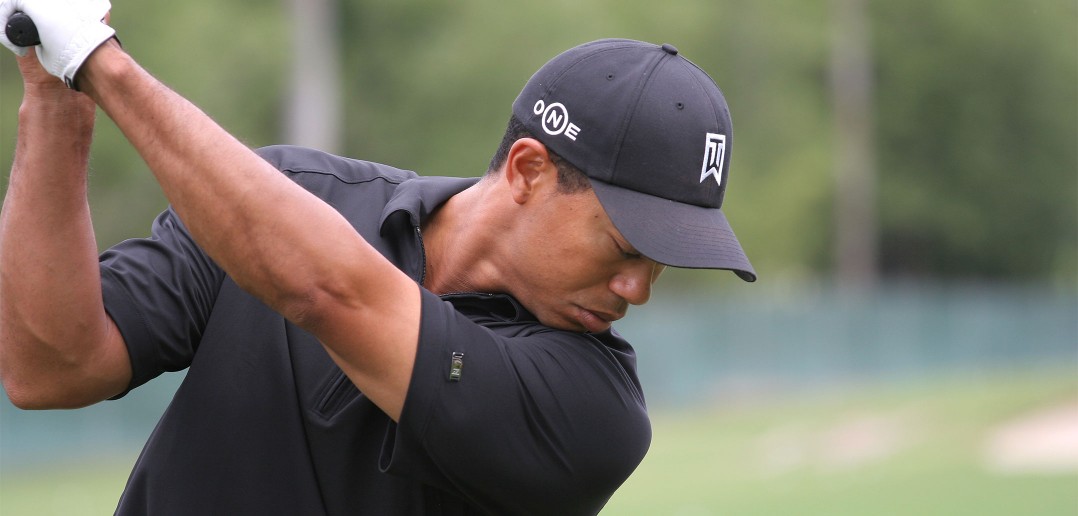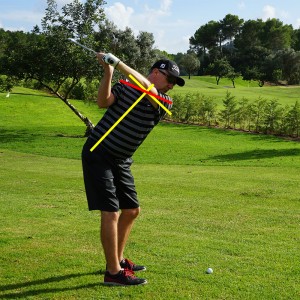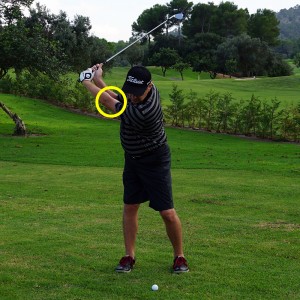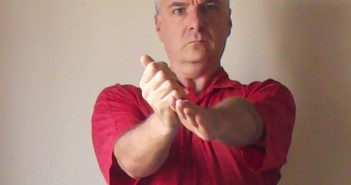This is a simple drill that will quickly teach you what a correct shoulder turn should feel like in a great golf swing.
Many amateur golfers, and even pros from time to time, suffer from a shoulder plane that is too flat in the backswing. In a great swing, your shoulders should turn back on a plane that is perpendicular to your spine at address – see Figure 1. Your shoulder plane is flat if your shoulders turn on a more horizontal plane – see Figure 2.
The problem with a shoulder plane that is too flat in the backswing is that it takes your arms and the golf club out of position, your hands and the club too far behind you at the top – see Figure 2. This then creates a shift in your swing planes in the downswing, which reduces the efficiency of your golf swing and means that you will have to make compensations in the downswing in order to square the club face consistently. A flat shoulder plane will also destabilise your spine and often cause your head and back to lift out of posture. As a result, you will lose power and have inconsistent ball striking.
Checking Your Backswing Shoulder Plane
To check if your shoulder plane is correct, you can record your swing on video from down the line. Using basic swing analysis software, simply draw a line from the base of your tailbone to the back of your neck at address (the spine angle line). Then draw another line just above the trailing shoulder and perpendicular to the spine angle line (the shoulder plane line) – see Figure 1. At the top of the backswing, if your lead shoulder is above the shoulder plane line then you have a flat shoulder plane – see Figure 2.
Another great way to check your shoulder plane is to practise your backswing in front of a mirror, face on, just as you do in the backswing section. At the top, your trail elbow should be hidden behind your lead elbow – see Figure 3. If, however, you can see your trailing elbow below your lead elbow, then your shoulder plane is flat – see Figure 4. Note that this check will only work if you move your arms correctly – see the backswing section – and you don’t have a “flying elbow”.
The Drill
Warm up as usual, we suggest The Perfect Golf Warm Up…

or Log In
…Now make some normal practice swings, looking for the same sensations. Your shoulders should be turning perfectly on-plane.If you have a tendency to get too flat in the backswing, you can use this drill at the beginning of the day to reset the desired feelings. Your downswing will be much simpler, and your ball striking will improve immeasurably.
Wedge Play
This is also a great drill to improve your wedge play. When the golf swing is shorter, many golfers struggle with a flat “armsy” swing, often resulting in weak shots sent out to the right.
For wedge play, let your right elbow fold in the takeaway move.
Notice how his drill forces you to take the club back more outside your hands, helps to keep you centred over the ball, and creates a steeper downswing plane with your hands more in front of your chest. From here, all you have to do is turn through and deliver the club – a much simpler, efficient and repeatable golf swing!
For more information, see the Wedge Play section.
Work on this drill, together with the instruction provided in the takeaway and backswing sections and you will quickly start to better understand what a great golf swing feels like. After just a few sessions you’ll start striking the ball better, more accurately and further than ever before!








